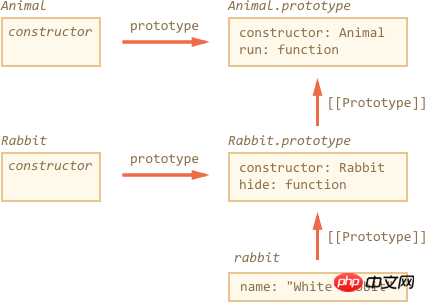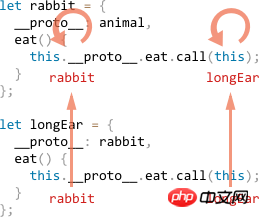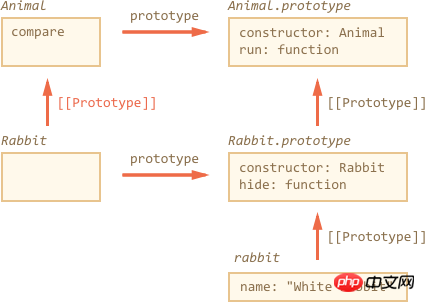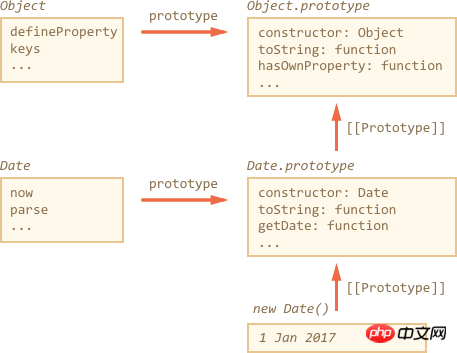ES6 클래스 상속 및 슈퍼 소개
이 글은 주로 ES6 클래스 상속과 super의 도입을 소개합니다. 이제 특정 참조 가치가 있으므로 필요한 친구들이 참조할 수 있습니다.
클래스 상속과 super# 🎜🎜#
class는 다른 클래스에서 확장될 수 있습니다. 기술적으로 프로토타입 상속을 기반으로 한 멋진 구문입니다. 객체를 상속하려면{..} 앞에 extends와 상위 객체를 지정해야 합니다. {..} 前指定 extends 和父对象。
这个 Rabbit 继承自 Animal:
class Animal {
constructor(name) {
this.speed = 0;
this.name = name;
}
run(speed) {
this.speed += speed;
alert(`${this.name} runs with speed ${this.speed}.`);
}
stop() {
this.speed = 0;
alert(`${this.name} stopped.`);
}
}
// Inherit from Animal
class Rabbit extends Animal {
hide() {
alert(`${this.name} hides!`);
}
}
let rabbit = new Rabbit("White Rabbit");
rabbit.run(5); // White Rabbit runs with speed 5.
rabbit.hide(); // White Rabbit hides!如你所见,如你所想,extend 关键字实际上是在 Rabbit.prototype 添加 [Prototype]],引用到 Animal.prototype。

所以现在 rabbit 既可以访问它自己的方法,也可以访问 Animal 的方法。
extends 后可跟表达式
Class 语法的 `extends' 后接的不限于指定一个类,更可以是表达式。
例如一个生成父类的函数:
function f(phrase) {
return class {
sayHi() { alert(phrase) }
}
}
class User extends f("Hello") {}
new User().sayHi(); // Hello例子中,class User 继承了 f('Hello')返回的结果。
对于高级编程模式,当我们使用的类是根据许多条件使用函数来生成时,这就很有用。
重写一个方法
现在让我们进入下一步,重写一个方法。到目前为止,Rabbit 从 Animal 继承了 stop 方法,this.speed = 0。
如果我们在 Rabbit 中指定了自己的 stop,那么会被优先使用:
class Rabbit extends Animal {
stop() {
// ...this will be used for rabbit.stop()
}
}......但通常我们不想完全替代父方法,而是在父方法的基础上调整或扩展其功能。我们进行一些操作,让它之前/之后或在过程中调用父方法。
Class 为此提供 super关键字。
使用
super.method(...)调用父方法。使用
super(...)调用父构造函数(仅在 constructor 函数中)。
例如,让兔子在 stop 时自动隐藏:
class Animal {
constructor(name) {
this.speed = 0;
this.name = name;
}
run(speed) {
this.speed += speed;
alert(`${this.name} runs with speed ${this.speed}.`);
}
stop() {
this.speed = 0;
alert(`${this.name} stopped.`);
}
}
class Rabbit extends Animal {
hide() {
alert(`${this.name} hides!`);
}
stop() {
super.stop(); // call parent stop
this.hide(); // and then hide
}
}
let rabbit = new Rabbit("White Rabbit");
rabbit.run(5); // White Rabbit runs with speed 5.
rabbit.stop(); // White Rabbit stopped. White rabbit hides!现在,Rabbit 的 stop 方法通过 super.stop() 调用父类的方法。
箭头函数无 super
正如在 arrow-functions 一章中提到,箭头函数没有 super。
它会从外部函数中获取 super。例如:
class Rabbit extends Animal {
stop() {
setTimeout(() => super.stop(), 1000); // call parent stop after 1sec
}
}箭头函数中的 super 与 stop() 中的相同,所以它按预期工作。如果我们在这里用普通函数,便会报错:
// Unexpected super
setTimeout(function() { super.stop() }, 1000);重写构造函数
对于构造函数来说,这有点棘手 tricky。
直到现在,Rabbit 都没有自己的 constructor。
Till now, Rabbit did not have its own constructor.
根据规范,如果一个类扩展了另一个类并且没有 constructor ,那么会自动生成如下 constructor:
class Rabbit extends Animal {
// generated for extending classes without own constructors
constructor(...args) {
super(...args);
}
}我们可以看到,它调用了父 constructor 传递所有参数。如果我们不自己写构造函数,就会发生这种情况。
现在我们将一个自定义构造函数添加到 Rabbit 中。除了name,我们还会设置 earLength:
class Animal {
constructor(name) {
this.speed = 0;
this.name = name;
}
// ...
}
class Rabbit extends Animal {
constructor(name, earLength) {
this.speed = 0;
this.name = name;
this.earLength = earLength;
}
// ...
}
// Doesn't work!
let rabbit = new Rabbit("White Rabbit", 10); // Error: this is not defined.哎呦出错了!现在我们不能生成兔子了,为什么呢?
简单来说:继承类中的构造函数必须调用 super(...),(!)并且在使用 this 之前执行它。
...但为什么?这是什么情况?嗯...这个要求看起来确实奇怪。
现在我们探讨细节,让你真正理解其中缘由 ——
在JavaScript中,继承了其他类的构造函数比较特殊。在继承类中,相应的构造函数被标记为特殊的内部属性 [[ConstructorKind]]:“derived”。
区别在于:
当一个普通的构造函数运行时,它会创建一个空对象作为 this,然后继续运行。
但是当派生的构造函数运行时,与上面说的不同,它指望父构造函数来完成这项工作。
所以如果我们正在构造我们自己的构造函数,那么我们必须调用 super,否则具有 this 的对象将不被创建,并报错。
对于 Rabbit 来说,我们需要在使用 this 之前调用 super(),如下所示:
class Animal {
constructor(name) {
this.speed = 0;
this.name = name;
}
// ...
}
class Rabbit extends Animal {
constructor(name, earLength) {
super(name);
this.earLength = earLength;
}
// ...
}
// now fine
let rabbit = new Rabbit("White Rabbit", 10);
alert(rabbit.name); // White Rabbit
alert(rabbit.earLength); // 10Super 的实现与 [[HomeObject]]
让我们再深入理解 super이 토끼는 동물에서 상속됩니다.
let animal = {
name: "Animal",
eat() {
alert(`${this.name} eats.`);
}
};
let rabbit = {
__proto__: animal,
name: "Rabbit",
eat() {
// that's how super.eat() could presumably work
this.__proto__.eat.call(this); // (*)
}
};
rabbit.eat(); // Rabbit eats.보시다시피, 생각하시는 대로 확장 키워드는 실제로 Animal.prototype을 참조하여 Rabbit.prototype에 [Prototype]]을 추가합니다.
![1531104369153034.png 719959942- 5b41c4dcd690b_articlex[1].png](https://img.php.cn//upload/image/427/232/559/1531104369153034.png) #🎜🎜##🎜🎜#이제
#🎜🎜##🎜🎜#이제 rabbit은 자체 메서드와 Animal의 메서드 모두에 액세스할 수 있습니다. #🎜🎜#
extends 뒤에 표현식이 올 수 있습니다.
#🎜🎜#클래스 구문 `extends'는 클래스 지정에만 국한되지 않고 표현식일 수도 있습니다. #🎜🎜##🎜🎜#예를 들어 부모 클래스를 생성하는 함수: #🎜🎜#let animal = {
name: "Animal",
eat() {
alert(`${this.name} eats.`);
}
};
let rabbit = {
__proto__: animal,
eat() {
// ...bounce around rabbit-style and call parent (animal) method
this.__proto__.eat.call(this); // (*)
}
};
let longEar = {
__proto__: rabbit,
eat() {
// ...do something with long ears and call parent (rabbit) method
this.__proto__.eat.call(this); // (**)
}
};
longEar.eat(); // Error: Maximum call stack size exceededclass User는 f('Hello가 반환한 결과를 상속합니다. '). #🎜🎜##🎜🎜#고급 프로그래밍 패턴의 경우 여러 조건에 따라 함수를 사용하여 생성된 클래스를 사용할 때 유용합니다. #🎜🎜#메서드 재정의
#🎜🎜#이제 다음 단계로 이동하여 메서드를 재정의해 보겠습니다. 지금까지Rabbit은 Animal, this.speed = 0에서 stop 메소드를 상속했습니다. #🎜🎜##🎜🎜#Rabbit에 자체 stop을 지정하면 먼저 사용됩니다: #🎜🎜#// inside longEar.eat() we have this = longEar this.__proto__.eat.call(this) // (**) // becomes longEar.__proto__.eat.call(this) // that is rabbit.eat.call(this);
super 키워드를 제공합니다. #🎜🎜#- #🎜🎜#부모 메소드를 호출하려면
super.method(...)를 사용하세요. #🎜🎜# - #🎜🎜#부모 생성자를 호출하려면
super(...)를 사용하세요(생성자 함수에서만). #🎜🎜#
중지할 때 토끼가 자동으로 숨도록 하려면: #🎜🎜#// inside rabbit.eat() we also have this = longEar this.__proto__.eat.call(this) // (*) // becomes longEar.__proto__.eat.call(this) // or (again) rabbit.eat.call(this);
Rabbit code>의 stop 메소드는 super.stop()을 통해 상위 클래스의 메소드를 호출합니다. #🎜🎜#화살표 함수에는 super가 없습니다.
#🎜🎜#화살표 함수 장에서 언급했듯이 화살표 함수에는 super가 없습니다. #🎜🎜##🎜🎜#외부 함수에서 super를 가져옵니다. 예: #🎜🎜#let animal = {
name: "Animal",
eat() { // [[HomeObject]] == animal
alert(`${this.name} eats.`);
}
};
let rabbit = {
__proto__: animal,
name: "Rabbit",
eat() { // [[HomeObject]] == rabbit
super.eat();
}
};
let longEar = {
__proto__: rabbit,
name: "Long Ear",
eat() { // [[HomeObject]] == longEar
super.eat();
}
};
longEar.eat(); // Long Ear eats.super는 stop()의 것과 동일하므로 예상대로 작동합니다. 여기서 일반 함수를 사용하면 오류가 보고됩니다. #🎜🎜#let animal = {
eat: function() { // should be the short syntax: eat() {...}
// ...
}
};
let rabbit = {
__proto__: animal,
eat: function() {
super.eat();
}
};
rabbit.eat(); // Error calling super (because there's no [[HomeObject]])생성자 재정의
#🎜🎜#생성자의 경우 이는 약간 까다롭습니다. #🎜🎜##🎜🎜# 지금까지Rabbit에는 자체 생성자가 없었습니다. 지금까지
Rabbit에는 자체 생성자가 없었습니다.#🎜🎜##🎜🎜#명세에 따르면 클래스가 다른 클래스를 확장하고 생성자가 아닌 경우 다음 생성자가 자동으로 생성됩니다. #🎜🎜#class Animal {
constructor(name, speed) {
this.speed = speed;
this.name = name;
}
run(speed = 0) {
this.speed += speed;
alert(`${this.name} runs with speed ${this.speed}.`);
}
static compare(animalA, animalB) {
return animalA.speed - animalB.speed;
}
}
// Inherit from Animal
class Rabbit extends Animal {
hide() {
alert(`${this.name} hides!`);
}
}
let rabbits = [
new Rabbit("White Rabbit", 10),
new Rabbit("Black Rabbit", 5)
];
rabbits.sort(Rabbit.compare);
rabbits[0].run(); // Black Rabbit runs with speed 5.생성자를 호출하는 것을 볼 수 있습니다. > 모든 매개변수를 전달합니다. 생성자를 직접 작성하지 않으면 이런 일이 발생합니다. #🎜🎜##🎜🎜#이제 Rabbit에 사용자 정의 생성자를 추가합니다. name 외에도 earLength도 설정합니다. #🎜🎜#class Animal {}
class Rabbit extends Animal {}
// for static propertites and methods
alert(Rabbit.__proto__ === Animal); // true
// and the next step is Function.prototype
alert(Animal.__proto__ === Function.prototype); // true
// that's in addition to the "normal" prototype chain for object methods
alert(Rabbit.prototype.__proto__ === Animal.prototype);super(...), (!)를 호출하고 this를 사용하기 전에 실행해야 합니다. #🎜🎜##🎜🎜#...근데 왜? 무슨 일이야? 흠... 그 요청이 이상한 것 같네요. #🎜🎜##🎜🎜#이제 그 이유를 진정으로 이해할 수 있도록 세부 사항에 대해 논의해 보겠습니다. #🎜🎜##🎜🎜#JavaScript에서 다른 클래스를 상속하는 생성자는 특별합니다. 상속된 클래스에서 해당 생성자는 특수 내부 속성 [[ConstructorKind]]: "derived"로 표시됩니다. #🎜🎜##🎜🎜#차이는 다음과 같습니다. #🎜🎜#- #🎜🎜#일반 생성자가 실행되면 이렇게 빈 객체가 생성되고 계속됩니다. 달리기. #🎜🎜#
- #🎜🎜#하지만 파생 생성자가 실행되면 위에서 말한 것과는 달리 부모 생성자가 작업을 수행하게 됩니다. #🎜🎜#
super를 호출해야 하고, 그렇지 않으면 this를 호출해야 합니다. 생성되지 않으며 오류가 보고됩니다. #🎜🎜##🎜🎜#Rabbit의 경우 this를 사용하기 전에 다음과 같이 super()를 호출해야 합니다. # 🎜🎜# // add one more method to it (can do more)
class PowerArray extends Array {
isEmpty() {
return this.length === 0;
}
}
let arr = new PowerArray(1, 2, 5, 10, 50);
alert(arr.isEmpty()); // false
let filteredArr = arr.filter(item => item >= 10);
alert(filteredArr); // 10, 50
alert(filteredArr.isEmpty()); // falseSuper의 구현과 [[HomeObject]]
#🎜🎜#super의 기본 구현을 더 자세히 이해해 보면 몇 가지 흥미로운 점을 보게 될 것입니다. #🎜🎜##🎜🎜#먼저 말씀드리고 싶은 것은 지금까지 배운 내용으로는 super 구현이 불가능하다는 것입니다. #🎜🎜#那么思考一下,这是什么原理?当一个对象方法运行时,它将当前对象作为 this。如果我们调用 super.method(),那么如何检索 method?很容易想到,我们需要从当前对象的原型中取出 method。从技术上讲,我们(或JavaScript引擎)可以做到这一点吗?
也许我们可以从 this 的 [[Prototype]] 中获得方法,就像 this .__ proto __.method 一样?不幸的是,这是行不通的。
让我们试一试,简单起见,我们不使用 class 了,直接使用普通对象。
在这里,rabbit.eat() 调用父对象的 animal.eat() 方法:
let animal = {
name: "Animal",
eat() {
alert(`${this.name} eats.`);
}
};
let rabbit = {
__proto__: animal,
name: "Rabbit",
eat() {
// that's how super.eat() could presumably work
this.__proto__.eat.call(this); // (*)
}
};
rabbit.eat(); // Rabbit eats.在 (*) 这一行,我们从原型(animal)中取出 eat,并以当前对象的上下文中调用它。请注意,.call(this) 在这里很重要,因为只写 this .__ proto __.eat() 的话 eat 的调用对象将会是 animal,而不是当前对象。
以上代码的 alert 是正确的。
但是现在让我们再添加一个对象到原型链中,就要出事了:
let animal = {
name: "Animal",
eat() {
alert(`${this.name} eats.`);
}
};
let rabbit = {
__proto__: animal,
eat() {
// ...bounce around rabbit-style and call parent (animal) method
this.__proto__.eat.call(this); // (*)
}
};
let longEar = {
__proto__: rabbit,
eat() {
// ...do something with long ears and call parent (rabbit) method
this.__proto__.eat.call(this); // (**)
}
};
longEar.eat(); // Error: Maximum call stack size exceeded噢,完蛋!调用 longEar.eat() 报错了!
这原因一眼可能看不透,但如果我们跟踪 longEar.eat() 调用,大概就知道为什么了。在 (*) 和 (**) 两行中, this 的值是当前对象(longEar)。重点来了:所有方法都将当前对象作为 this,而不是原型或其他东西。
因此,在两行 (*) 和 (**) 中,this.__ proto__ 的值都是 rabbit。他们都调用了 rabbit.eat,于是就这么无限循环下去。
情况如图:

1.在 longEar.eat() 里面,(**) 行中调用了 rabbit.eat,并且this = longEar。
// inside longEar.eat() we have this = longEar this.__proto__.eat.call(this) // (**) // becomes longEar.__proto__.eat.call(this) // that is rabbit.eat.call(this);
2.然后在rabbit.eat的 (*) 行中,我们希望传到原型链的下一层,但是 this = longEar,所以 this .__ proto __.eat又是 rabbit.eat!
// inside rabbit.eat() we also have this = longEar this.__proto__.eat.call(this) // (*) // becomes longEar.__proto__.eat.call(this) // or (again) rabbit.eat.call(this);
...因此
rabbit.eat在无尽循环调动,无法进入下一层。
这个问题不能简单使用 this 解决。
[[HomeObject]]
为了提供解决方案,JavaScript 为函数添加了一个特殊的内部属性:[[HomeObject]]。
当函数被指定为类或对象方法时,其 [[HomeObject]] 属性为该对象。
这实际上违反了 unbind 函数的思想,因为方法记住了它们的对象。并且 [[HomeObject]] 不能被改变,所以这是永久 bind(绑定)。所以在 JavaScript 这是一个很大的变化。
但是这种改变是安全的。 [[HomeObject]] 仅用于在 super 中获取下一层原型。所以它不会破坏兼容性。
让我们来看看它是如何在 super 中运作的:
let animal = {
name: "Animal",
eat() { // [[HomeObject]] == animal
alert(`${this.name} eats.`);
}
};
let rabbit = {
__proto__: animal,
name: "Rabbit",
eat() { // [[HomeObject]] == rabbit
super.eat();
}
};
let longEar = {
__proto__: rabbit,
name: "Long Ear",
eat() { // [[HomeObject]] == longEar
super.eat();
}
};
longEar.eat(); // Long Ear eats.每个方法都会在内部 [[HomeObject]] 属性中记住它的对象。然后 super 使用它来解析原型。
在类和普通对象中定义的方法中都定义了 [[HomeObject]],但是对于对象,必须使用:method() 而不是 "method: function()"。
在下面的例子中,使用非方法语法(non-method syntax)进行比较。这么做没有设置 [[HomeObject]] 属性,继承也不起作用:
let animal = {
eat: function() { // should be the short syntax: eat() {...}
// ...
}
};
let rabbit = {
__proto__: animal,
eat: function() {
super.eat();
}
};
rabbit.eat(); // Error calling super (because there's no [[HomeObject]])静态方法和继承
class 语法也支持静态属性的继承。
例如:
class Animal {
constructor(name, speed) {
this.speed = speed;
this.name = name;
}
run(speed = 0) {
this.speed += speed;
alert(`${this.name} runs with speed ${this.speed}.`);
}
static compare(animalA, animalB) {
return animalA.speed - animalB.speed;
}
}
// Inherit from Animal
class Rabbit extends Animal {
hide() {
alert(`${this.name} hides!`);
}
}
let rabbits = [
new Rabbit("White Rabbit", 10),
new Rabbit("Black Rabbit", 5)
];
rabbits.sort(Rabbit.compare);
rabbits[0].run(); // Black Rabbit runs with speed 5.现在我们可以调用 Rabbit.compare,假设继承的 Animal.compare 将被调用。
它是如何工作的?再次使用原型。正如你猜到的那样,extends 同样给 Rabbit 提供了引用到 Animal的 [Prototype]。

所以,Rabbit 函数现在继承 Animal 函数。Animal 自带引用到 Function.prototype 的 [[Prototype]](因为它不 extend 其他类)。
看看这里:
class Animal {}
class Rabbit extends Animal {}
// for static propertites and methods
alert(Rabbit.__proto__ === Animal); // true
// and the next step is Function.prototype
alert(Animal.__proto__ === Function.prototype); // true
// that's in addition to the "normal" prototype chain for object methods
alert(Rabbit.prototype.__proto__ === Animal.prototype);这样 Rabbit 可以访问 Animal 的所有静态方法。
在内置对象中没有静态继承
请注意,内置类没有静态 [[Prototype]] 引用。例如,Object 具有 Object.defineProperty,Object.keys等方法,但 Array,Date 不会继承它们。
Date 和 Object 的结构:

Date 和 Object 之间毫无关联,他们独立存在,不过 Date.prototype 继承于 Object.prototype,仅此而已。
造成这个情况是因为 JavaScript 在设计初期没有考虑使用 class 语法和继承静态方法。
原生拓展
Array,Map 等内置类也可以扩展。
举个例子,PowerArray 继承自原生 Array:
// add one more method to it (can do more)
class PowerArray extends Array {
isEmpty() {
return this.length === 0;
}
}
let arr = new PowerArray(1, 2, 5, 10, 50);
alert(arr.isEmpty()); // false
let filteredArr = arr.filter(item => item >= 10);
alert(filteredArr); // 10, 50
alert(filteredArr.isEmpty()); // false请注意一件非常有趣的事情。像 filter,map 和其他内置方法 - 返回新的继承类型的对象。他们依靠 constructor 属性来做到这一点。
在上面的例子中,
arr.constructor === PowerArray
所以当调用 arr.filter() 时,它自动创建新的结果数组,就像 new PowerArray 一样,于是我们可以继续使用 PowerArray 的方法。
我们甚至可以自定义这种行为。如果存在静态 getter Symbol.species,返回新建对象使用的 constructor。
下面的例子中,由于 Symbol.species 的存在,map,filter等内置方法将返回普通的数组:
class PowerArray extends Array {
isEmpty() {
return this.length === 0;
}
// built-in methods will use this as the constructor
static get [Symbol.species]() {
return Array;
}
}
let arr = new PowerArray(1, 2, 5, 10, 50);
alert(arr.isEmpty()); // false
// filter creates new array using arr.constructor[Symbol.species] as constructor
let filteredArr = arr.filter(item => item >= 10);
// filteredArr is not PowerArray, but Array
alert(filteredArr.isEmpty()); // Error: filteredArr.isEmpty is not a function我们可以在其他 key 使用 Symbol.species,可以用于剥离结果值中的无用方法,或是增加其他方法。
以上就是本文的全部内容,希望对大家的学习有所帮助,更多相关内容请关注PHP中文网!
相关推荐:
위 내용은 ES6 클래스 상속 및 슈퍼 소개의 상세 내용입니다. 자세한 내용은 PHP 중국어 웹사이트의 기타 관련 기사를 참조하세요!

핫 AI 도구

Undresser.AI Undress
사실적인 누드 사진을 만들기 위한 AI 기반 앱

AI Clothes Remover
사진에서 옷을 제거하는 온라인 AI 도구입니다.

Undress AI Tool
무료로 이미지를 벗다

Clothoff.io
AI 옷 제거제

AI Hentai Generator
AI Hentai를 무료로 생성하십시오.

인기 기사

뜨거운 도구

메모장++7.3.1
사용하기 쉬운 무료 코드 편집기

SublimeText3 중국어 버전
중국어 버전, 사용하기 매우 쉽습니다.

스튜디오 13.0.1 보내기
강력한 PHP 통합 개발 환경

드림위버 CS6
시각적 웹 개발 도구

SublimeText3 Mac 버전
신 수준의 코드 편집 소프트웨어(SublimeText3)

뜨거운 주제
 7482
7482
 15
15
 1377
1377
 52
52
 77
77
 11
11
 51
51
 19
19
 19
19
 34
34
 WebSocket과 JavaScript를 사용하여 온라인 음성 인식 시스템을 구현하는 방법
Dec 17, 2023 pm 02:54 PM
WebSocket과 JavaScript를 사용하여 온라인 음성 인식 시스템을 구현하는 방법
Dec 17, 2023 pm 02:54 PM
WebSocket 및 JavaScript를 사용하여 온라인 음성 인식 시스템을 구현하는 방법 소개: 지속적인 기술 개발로 음성 인식 기술은 인공 지능 분야의 중요한 부분이 되었습니다. WebSocket과 JavaScript를 기반으로 한 온라인 음성 인식 시스템은 낮은 대기 시간, 실시간, 크로스 플랫폼이라는 특징을 갖고 있으며 널리 사용되는 솔루션이 되었습니다. 이 기사에서는 WebSocket과 JavaScript를 사용하여 온라인 음성 인식 시스템을 구현하는 방법을 소개합니다.
 WebSocket 및 JavaScript: 실시간 모니터링 시스템 구현을 위한 핵심 기술
Dec 17, 2023 pm 05:30 PM
WebSocket 및 JavaScript: 실시간 모니터링 시스템 구현을 위한 핵심 기술
Dec 17, 2023 pm 05:30 PM
WebSocket과 JavaScript: 실시간 모니터링 시스템 구현을 위한 핵심 기술 서론: 인터넷 기술의 급속한 발전과 함께 실시간 모니터링 시스템이 다양한 분야에서 널리 활용되고 있다. 실시간 모니터링을 구현하는 핵심 기술 중 하나는 WebSocket과 JavaScript의 조합입니다. 이 기사에서는 실시간 모니터링 시스템에서 WebSocket 및 JavaScript의 적용을 소개하고 코드 예제를 제공하며 구현 원칙을 자세히 설명합니다. 1. 웹소켓 기술
 JavaScript 및 WebSocket을 사용하여 실시간 온라인 주문 시스템을 구현하는 방법
Dec 17, 2023 pm 12:09 PM
JavaScript 및 WebSocket을 사용하여 실시간 온라인 주문 시스템을 구현하는 방법
Dec 17, 2023 pm 12:09 PM
JavaScript 및 WebSocket을 사용하여 실시간 온라인 주문 시스템을 구현하는 방법 소개: 인터넷의 대중화와 기술의 발전으로 점점 더 많은 레스토랑에서 온라인 주문 서비스를 제공하기 시작했습니다. 실시간 온라인 주문 시스템을 구현하기 위해 JavaScript 및 WebSocket 기술을 사용할 수 있습니다. WebSocket은 TCP 프로토콜을 기반으로 하는 전이중 통신 프로토콜로 클라이언트와 서버 간의 실시간 양방향 통신을 실현할 수 있습니다. 실시간 온라인 주문 시스템에서는 사용자가 요리를 선택하고 주문을 하면
 WebSocket과 JavaScript를 사용하여 온라인 예약 시스템을 구현하는 방법
Dec 17, 2023 am 09:39 AM
WebSocket과 JavaScript를 사용하여 온라인 예약 시스템을 구현하는 방법
Dec 17, 2023 am 09:39 AM
WebSocket과 JavaScript를 사용하여 온라인 예약 시스템을 구현하는 방법 오늘날의 디지털 시대에는 점점 더 많은 기업과 서비스에서 온라인 예약 기능을 제공해야 합니다. 효율적인 실시간 온라인 예약 시스템을 구현하는 것이 중요합니다. 이 기사에서는 WebSocket과 JavaScript를 사용하여 온라인 예약 시스템을 구현하는 방법을 소개하고 구체적인 코드 예제를 제공합니다. 1. WebSocket이란 무엇입니까? WebSocket은 단일 TCP 연결의 전이중 방식입니다.
 JavaScript와 WebSocket: 효율적인 실시간 일기예보 시스템 구축
Dec 17, 2023 pm 05:13 PM
JavaScript와 WebSocket: 효율적인 실시간 일기예보 시스템 구축
Dec 17, 2023 pm 05:13 PM
JavaScript 및 WebSocket: 효율적인 실시간 일기 예보 시스템 구축 소개: 오늘날 일기 예보의 정확성은 일상 생활과 의사 결정에 매우 중요합니다. 기술이 발전함에 따라 우리는 날씨 데이터를 실시간으로 획득함으로써 보다 정확하고 신뢰할 수 있는 일기예보를 제공할 수 있습니다. 이 기사에서는 JavaScript 및 WebSocket 기술을 사용하여 효율적인 실시간 일기 예보 시스템을 구축하는 방법을 알아봅니다. 이 문서에서는 특정 코드 예제를 통해 구현 프로세스를 보여줍니다. 우리
 jQuery를 사용하여 요소의 클래스 이름 바꾸기
Feb 24, 2024 pm 11:03 PM
jQuery를 사용하여 요소의 클래스 이름 바꾸기
Feb 24, 2024 pm 11:03 PM
jQuery는 웹 개발에 널리 사용되는 클래식 JavaScript 라이브러리로, 이벤트 처리, DOM 요소 조작, 웹 페이지에서 애니메이션 수행과 같은 작업을 단순화합니다. jQuery를 사용할 때 요소의 클래스 이름을 바꿔야 하는 상황이 자주 발생합니다. 이 기사에서는 몇 가지 실용적인 방법과 구체적인 코드 예제를 소개합니다. 1. RemoveClass() 및 addClass() 메소드 사용 jQuery는 삭제를 위한 RemoveClass() 메소드를 제공합니다.
 간단한 JavaScript 튜토리얼: HTTP 상태 코드를 얻는 방법
Jan 05, 2024 pm 06:08 PM
간단한 JavaScript 튜토리얼: HTTP 상태 코드를 얻는 방법
Jan 05, 2024 pm 06:08 PM
JavaScript 튜토리얼: HTTP 상태 코드를 얻는 방법, 특정 코드 예제가 필요합니다. 서문: 웹 개발에서는 서버와의 데이터 상호 작용이 종종 포함됩니다. 서버와 통신할 때 반환된 HTTP 상태 코드를 가져와서 작업의 성공 여부를 확인하고 다양한 상태 코드에 따라 해당 처리를 수행해야 하는 경우가 많습니다. 이 기사에서는 JavaScript를 사용하여 HTTP 상태 코드를 얻는 방법과 몇 가지 실용적인 코드 예제를 제공합니다. XMLHttpRequest 사용
 자바스크립트에서 insertBefore를 사용하는 방법
Nov 24, 2023 am 11:56 AM
자바스크립트에서 insertBefore를 사용하는 방법
Nov 24, 2023 am 11:56 AM
사용법: JavaScript에서 insertBefore() 메서드는 DOM 트리에 새 노드를 삽입하는 데 사용됩니다. 이 방법에는 삽입할 새 노드와 참조 노드(즉, 새 노드가 삽입될 노드)라는 두 가지 매개 변수가 필요합니다.




